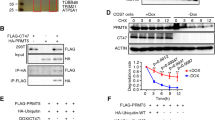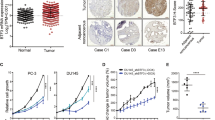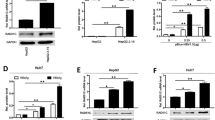Abstract
The RNA-binding motif (RRM) gene on Y chromosome (RBMY), encoding a male germ cell-specific RNA-binding protein associated with spermatogenesis, was found inserted by hepatitis B virus (HBV) DNA in one childhood hepatocellular carcinoma (HCC). This study is aimed to explore the oncogenic potential of the RBMY protein. The RBMY transcripts, expressed exclusively in the testis of normal people, were detected by reverse transcription–polymerase chain reaction in 36% of HCCs from 90 males and in 67% of hepatoblastoma from six boys. The nontumor liver counter parts, cirrhotic liver tissues from children with biliary atresia, and other types of cancers, such as bile duct, colon, stomach, lung, prostate, and kidney, were all negative for RBMY expression. One to four types of RBMY transcripts, including wild type and variants with N-terminal RRM deletion, C-terminal SRGY (serine-arginine-glycine-tyrosine) boxes deletion, or deletion of both domains, were found in the testis and liver cancer tissues. The wild-type RBMY protein was expressed in the nucleus and demonstrated its tumorigenicity by transformation of mouse fibroblast NIH3T3 cells and in vivo tumor formation. The RBMY variant protein with deletion of C-terminal exons 9–12 was trapped in the cytoplasm and showed decreased tumorigenicity. Our results suggest that RBMY is a new candidate oncogene specific for male liver cancer.
This is a preview of subscription content, access via your institution
Access options
Subscribe to this journal
Receive 50 print issues and online access
$259.00 per year
only $5.18 per issue
Buy this article
- Purchase on Springer Link
- Instant access to full article PDF
Prices may be subject to local taxes which are calculated during checkout



Similar content being viewed by others
References
Bréchot C, Gozuacik D, Murakami Y and Paterlini-Bréchot P . (2000). Semin. Cancer Biol., 10, 211–231.
Buendia MA . (2000). Semin. Cancer Biol., 10, 185–200.
Byrne JA, Simms LA, Little MH, Algar EM and Smith PJ . (1993). Genes Chromosomes Cancer, 8, 104–111.
Chai NN, Salido EC and Yen PH . (1997). Genomics, 45, 355–361.
Chai NN, Zhou HY, Hernandez J, Najmabadi H, Bhasin S and Yen PH . (1998). Genomics, 49, 283–289.
Chang MH, Chen DS, Hsu HC, Wu MZ, Hsu HY and Lee CY . (1989). Cancer, 64, 2377–2380.
Chen JY, Harrison TJ, Lee CS, Chen DS and Zuckerman AJ . (1986). Br. J. Exp. Pathol., 67, 279–288.
Chen WJ, Lee JC and Hung WT . (1988). J. Pediatr. Surg., 23, 457–461.
Ding SF, Michail NE and Habib NA . (1994). J. Hepatol., 20, 672–675.
Elliott DJ, Bourgeois CF, Klink A, Stévenin J and Cooke HJ . (2000). Proc. Natl. Acad. Sci. USA, 97, 5717–5722.
Elliott DJ, Millar MR, Oghene K, Ross A, Kiesewetter F, Pryor J, McIntyre M, Hargreave TB, Saunders PTK, Vogt PH, Chandley AC and Cooke H . (1997). Proc. Natl. Acad. Sci. USA, 94, 3848–3853.
Elliott DJ, Oghene K, Makarov G, Makarova O, Hargreave TB, Chandley AC, Eperon IC and Cook HJ . (1998). J. Cell Sci., 111, 1255–1265.
Exelby PR, Filler RM and Grosfeld JL . (1975). J. Pediatr. Surg., 10, 329–337.
Flickinger JC, Carr BI and Lotze MT . (1997). Cancer: Principles and Practice of Oncology, 5th edn. DeVita VT, Hellman S and Rosenberg SA (eds) Lippincott-Raven Publishers: Philadelphia, PA, pp 1087–1097.
Geran RI, Greenberg NH, Mac Donald MM, Schumacher AM and Abbot BJ . (1972). Cancer Chemother. Rep., 3, 1–16.
Idilman R, De Maria N, Colantoni A and Van Thiel DH . (1998). J. Virol. Hepatol., 5, 285–299.
Iwama T and Mishima Y . (1994). Cancer, 73, 2065–2068.
Jiang ZH and Wu JY . (1999). Proc. Soc. Exp. Biol. Med., 220, 64–72.
Kume T, Oshima K, Shinohara T, Takeo H, Yamashita Y, Shirakusa T and Kikuchi M . (1999). Histopathology, 34, 502–509.
Lee CL and Ko YC . (1998). Eur. J. Cancer, 34, 2064–2067.
Lin TM, Chang TC and Chen KP . (1977). Taiwan I Hsueh Hui Tsa Chih, 76, 656–658.
Lin Y, Shi CY, Li B, Soo BH, Mohammed AS, Wee A, Oon CJ, Mack PO and Chan SH . (1996). Ann. Acad. Med. Singapore, 25, 22–30.
Lingenfelter PA, Delbridge ML, Thomas S, Hoekstra HE, Mitchell MJ, Graves JAM and Disteche CM . (2001). Mamm. Genome, 12, 538–545.
Ma K, Inglis JD, Sharkey A, Bickmore WA, Hill RE, Prosser EJ, Speed RM, Thomson EJ, Jobling M, Taylor K, Wolfe J, Cooke HJ, Hargreave TB and Chandley AC . (1993). Cell, 75, 1287–1295.
Mercatante D and Kole R . (2000). Pharmacol. Ther., 85, 237–243.
Miyoshi Y, Iwao K, Nagasawa Y, Aihara T, Sasaki Y, Imaoka S, Murata M, Shimano T and Nakamura Y . (1998). Cancer Res., 58, 2524–2527.
Montesano R, Hainaut P and Wild CP . (1997). J. Natl. Cancer Inst., 89, 1844–1851.
Nagai K, Oubridge C, Ito N, Avis J and Evans P . (1995). Trends Biochem. Sci., 20, 235–240.
Najmabadi H, Huang V, Yen P, Subbarao MN, Bhasin D, Banang L, Naseeruddin S, de Kretser DM, Baker HWG, McLachlan RI, Loveland KA and Bhasin S . (1996). J. Clin. Endocrinol. Metab., 81, 1347–1352.
Nakahori Y, Kuroki Y, Komaki R, Kondoh N, Namiki M, Iwamoto T, Toda T and Kobayashi K . (1996). Horm. Res., 46, 20–23.
Ni YH, Chang MH, Hsu HY, Chen CC, Chen WJ and Lee CY . (1991). Cancer, 8, 1731–1741.
Nishida N, Fukuda Y, Komeda T, Kita R, Sando T, Furukawa M, Amenomori M, Shibagaki I, Nakao K, Ikenaga M and Ishizaki K . (1994). Cancer Res., 54, 3107–3110.
Peng SY, Lai PL and Hsu HC . (1993). J. Formos. Med. Assoc., 92, n866–870.
Tsuei DJ, Chang MH, Chen PJ, Hsu TY and Ni YH . (2002). J. Med. Virol., 68, 513–521.
Valcárcel J and Green MR . (1996). Trends Biochem. Sci., 21, 296–301.
Venables J and Eperon I . (1999). Curr. Opin. Genet. Dev., 9, 346–354.
Venables JP, Elliott DJ, Makarova OV, Makarov EM, Cooke HJ and Eperon IC . (2000). Hum. Mol. Genet., 9, 685–694.
Venables JP, Vernet C, Chew SL, Elliott DJ, Cowmeadow RB, Wu J, Cooke HJ, Artzt K and Eperon IC . (1999). Hum. Mol. Genet., 8, 959–969.
Vernet C and Artzt K . (1997). Trends Genet., 13, 479–484.
Vogt PH, Edelmann A, Kirsch S, Henegariu O, Hirschmann P, Kiesewetter P, Köhn FM, Schill WB, Farah S, Ramos C, Hartmann M, Hartschuh W, Meschede D, Behre HM, Castel A, Nieschlag E, Weidner W, Grone HJ, Jung A, Engel W and Haidl G . (1996). Hum. Mol. Genet., 5, 933–943.
Acknowledgements
We thank Dr Lih-Hwa Hwang of the Hepatitis Research Center, National Taiwan University Hospital for reading the manuscript and helpful suggestion, and Dr Li-Min Huang of the Department of Pediatrics, National Taiwan University Hospital for giving the plasmid pcDNA3-3HA. This work was supported by Grants NHRI-EX91-9117BN and NHRI-EX92-9117BN from the National Health Research Institute (to MHC) and NHRI-GT-EX89B701L (to HCH).
Author information
Authors and Affiliations
Corresponding author
Rights and permissions
About this article
Cite this article
Tsuei, DJ., Hsu, HC., Lee, PH. et al. RBMY, a male germ cell-specific RNA-binding protein, activated in human liver cancers and transforms rodent fibroblasts. Oncogene 23, 5815–5822 (2004). https://doi.org/10.1038/sj.onc.1207773
Received:
Revised:
Accepted:
Published:
Issue Date:
DOI: https://doi.org/10.1038/sj.onc.1207773
Keywords
This article is cited by
-
Y chromosome is moving out of sex determination shadow
Cell & Bioscience (2022)
-
Sexual dimorphism in hepatitis B and C and hepatocellular carcinoma
Seminars in Immunopathology (2019)
-
Genetics of the human Y chromosome and its association with male infertility
Reproductive Biology and Endocrinology (2018)
-
Aberrant activation of the human sex-determining gene in early embryonic development results in postnatal growth retardation and lethality in mice
Scientific Reports (2017)
-
Gender disparity in hepatocellular carcinoma (HCC): multiple underlying mechanisms
Science China Life Sciences (2017)



